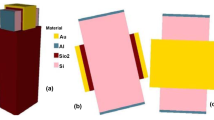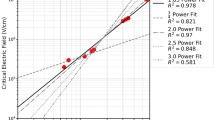Abstract
We have developed a two-dimensional analytical model for the channel potential, threshold voltage, and drain-to-source current of a symmetric double-halo gate-stacked triple-material double-gate metal–oxide–semiconductor field-effect transistor (MOSFET). The two-dimensional Poisson’s equation is solved to obtain the channel potential. For accurate modeling of the device, fringing capacitance and effective surface charge are considered. The basic drift–diffusion equation is used to model the drain-to-source current. The midchannel potential of the device is used instead of the surface potential in the current modeling, considering the fact that the punch-through current is not confined only to the surface in a fully depleted MOSFET. An expression for the pinch-off voltage is derived to model the drain current in the saturation region accurately. Various short-channel effects such as drain-induced barrier lowering, gate leakage, threshold voltage, and roll-off have also been investigated. This structure shows excellent ability to suppress various short-channel effects. The results of the proposed model are validated against data obtained from a commercially available numerical device simulator.











Similar content being viewed by others
References
Ernst, T., Cristoloveanu, S., Ghibaudo, G., Ouisee, T., Horiguchi, S., Ono, Y., Takahashi, Y., Murase, K.: Ultimately thin double-gate SOI MOSFETs. IEEE Trans. Electron Devices 50, 830–838 (2003)
Suzuki, K., Tosaka, Y., Tanaka, T., Horie, H., Arimoto, Y.: Scaling theory of double-gate SOI MOSFETs. IEEE Trans. Electron Devices 40, 2326–2329 (1993)
Lu, H., Taur, Y.: An analytical potential model for symmetric and asymmetric DG MOSFETs. IEEE Trans. Electron Devices 53, 1161–1168 (2007)
Chen, Q., Harrell II, E.M., Meindl, J.D.: A physical short-channel threshold voltage model for undoped symmetric double-gate MOSFETs. IEEE Trans. Electron Devices 50(7), 1631–1637 (2003)
Taur, Y.: An analytical solution to a double-gate MOSFET with undoped body. IEEE Trans. Electron Devices 21(5), 245–247 (2002)
Tsormpatzoglou, A., Dimitriadis, C.A., Clerc, R., Pananakakis, G.: Threshold voltage model for short-channel undoped symmetrical double-gate MOSFETs. IEEE Trans. Electron Devices 55(9), 2512–2516 (2008)
Cerdeira, A., Moldovan, O., Iniguez, B., Estrada, M.: Modeling of potentials and threshold voltage for symmetric doped double-gate MOSFETs. Solid State Electron. 52(5), 830–837 (2008)
Reddy, G.V., Kumar, M.J.: A new dual-material double-gate (DMDG) nanoscale SOI MOSFET-two-dimensional analytical modeling and simulation. IEEE Trans. Nanotechnol. 4, 260–268 (2005)
Sarkhel, S., Naha, S., Sarkar, S.K.: Reduced SCEs in fully depleted dual-material double-gate (DMDG) SON MOSFET: analytical modeling and simulation. Int. J. Sci. Eng. Res. 3, 1–5 (2012)
Pal, A., Sarkar, A.: Analytical study of dual material surrounding gate MOSFET to suppress short-channel effects (SCEs). Eng. Sci. Technol. 17(4), 205–212 (2014)
Li, C., Zhuang, Y., Han, R.: Cylindrical surrounding-gate MOSFETs with electrically induced source/drain extension. Microelectron. J. 42, 341–346 (2011)
Sarkar, A., De, S., Sarkar, C.K.: Asymmetric halo and single-halo dual-material gate and double halo double material gate n-MOSFETs characteristic parameter modeling. Int. J. Numer. Model. 26, 41–55 (2013)
Dhanaselvama, P.S., Balamurugana, N.B.: Analytical approach of a nanoscale triple-material surrounding gate (TMSG) MOSFETs for reduced short-channel effects. Microelectron. J. 44, 400–404 (2013)
Razavi, P., Orouji, A.A.: Nanoscale triple material double gate (TM-DG) MOSFET for improving short channel effects. In: International Conference on Advances in Electronics and Microelectronics, pp. 11–14 (2008)
Tiwari, P.K., Dubey, S., Singh, M., Jit, S.: A two-dimensional analytical model for threshold voltage of short-channel triple-material double gate metal-oxide-semiconductor field effect transistor. J. Appl. Phys. 108, 074508 (2010)
Inani, A., Rao, R.V., Cheng, B., Woo, Z.: Gate stack architecture analysis and channel engineering in deep sub-micron MOSFETs. Jpn. J. Appl. Phys. 38, 2266 (1999)
Cheng, B., Cao, M., Rao, R., Inani, A., Voorde, P.V., Greene, W.M., Stork, J.M.C., Yu, Z., Zeitzoff, P.M., Woo, J.C.S.: The impact of high-k gate dielectrics and metal gate electrodes on sub-100 nm MOSFETs. IEEE Trans. Electron Devices 46, 1537–1544 (1999)
Tsividis, Y.: Operation and Modelling of the MOS Transistor, 2nd edn. McGraw-Hill, New York (1989)
Pradhan, K.P., Mohapatra, S.K., Agarwal, P.K., Sahu, P.K., Behera, D.K., Mishra, J.: Symmetric DG-MOSFET with gate and channel engineering: a 2-D simulation study. Microelectron. Solid State Electron. 2, 1–9 (2013)
Bentrcia, T., Djeffal, F., Benhaya, A.H.: Continuous analytic I-V model for GS DG MOSFETs including hot-carrier degradation effects. J. Semicond. 33, 014001 (2012)
Park, H.J., Ko, P.K., Hu, C.: A charge sheet capacitance model of short channel MOSFET’s for spice. IEEE Trans. Comput. Aided Des. 10(3), 376–389 (1991)
Young, K.K.: Short channel effect in fully depleted SOI MOSFETs. IEEE Trans. Electron Devices 36, 399–402 (1989)
Yan, R.H., Ourmazd, A., Lee, K.F.: Scaling the Si MOSFET: from bulk to SOI. IEEE Trans. Electron Devices 39, 1704–1710 (1992)
Arora, N.D.: MOSFET Models for VLSI Circuits Simulation. Springer, New York (1993)
Sodini, C.G., Ko, P.-K., Moll, J.L.: The effect of high fields on MOS device and circuit performance. IEEE Trans. Electron Devices 31, 1386–1393 (1984)
Akers, A.: The effect of field dependent mobility on the threshold voltage of a small geometry MOSFET. Solid State Electron. 23, 173–175 (1989)
Merckel, G.: CAD Models of MOSFETs. Process and Device Modeling for Integrated Circuit Design. Noordoff, Leyden (1977)
Hamid, H.A.E., Guitart, J.R., Iniguez, B.: Analytical model of the threshold voltage and subthreshold swing of undoped cylindrical gate-all-around-based MOSFETs. IEEE Trans. Electron Devices 54, 572–579 (2007)
Kumar, A., Kedzierski, J., Laux, S.E.: Quantam-based simulation analysis of scaling in ultrathin body device structures. IEEE Trans. Electron Devices 52, 614–617 (2005)
Neaman, A.D.: Semiconductor Physics and Devices. Tata Mcgraw-Hill, New Delhi (1992)
Sverdrup, P.G., Sinha, S., Asheghi, M., Uma, S., Goodson, K.E.: Measurement of ballistic phonon conduction near hotspots in silicon. Appl. Phys. Lett. 78(21), 3331–3333 (2001)
Author information
Authors and Affiliations
Corresponding author
Appendices
Appendix 1
The expressions for \(G_{j}\) and \(H_{j}\) (\(j=1,2,3,4,5\)) are listed below:
Appendix 2
The expressions for \({V}_{\mathrm{thL}}\) and \(U_{1}\)–\(U_{7}\) are given below:
where \(V_{\mathrm{FD}}^{\mathrm{th}}=V_{\mathrm{FD}}\) at \(V_{\mathrm{GS}}=V_{\mathrm{th}}\) and \(V_{\mathrm{thL}}\) is the long-channel threshold voltage, which is independent of channel length.
Rights and permissions
About this article
Cite this article
Mahmud, M.A., Subrina, S. Two-dimensional analytical model of threshold voltage and drain current of a double-halo gate-stacked triple-material double-gate MOSFET. J Comput Electron 15, 525–536 (2016). https://doi.org/10.1007/s10825-016-0820-7
Published:
Issue Date:
DOI: https://doi.org/10.1007/s10825-016-0820-7




